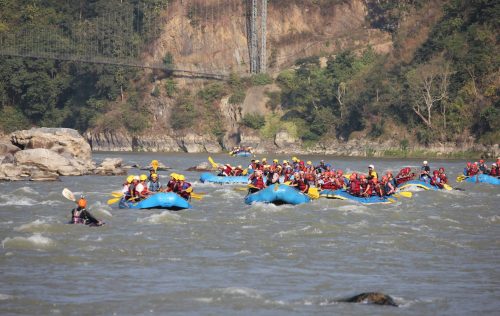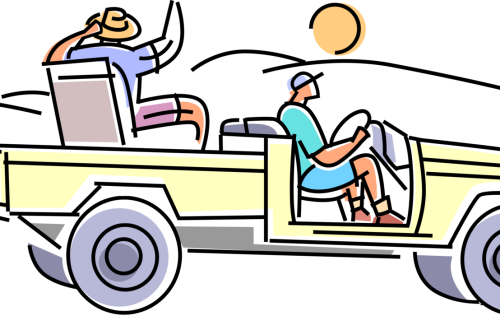CHAPTER- FIVET
5.1. Introduction
Travel and Tourism are normally used interchangeably in normal conversations though the two do not mean one thing. Even though the transport industry gives the link that is amid dwelling and destination regions of tourists, but the industry's role as an agent responsible for making tourists reach these destinations has been considered as tourism. Tourism world over cannot exist in isolation from transport and therefore it can be stated in other terms that there is a strong positive correlation between tourism and transport The improvement or modernization of transport or deterioration of the same has a direct impact tourism. The history of tourism and that of transport provides a clear understanding of this shared relationship. Transportation can be discussed without taking tourism into consideration but clearly tourism cannot thrive without travel. Transportation is an essential part of tourism industry and is principally due to the improvements of transportation that tourism has expanded.
Historically, the key technical transformations brought about by the industrial revolution towards the end of the 18th century, no forms of motorized transportation existed by then. Transport technology was mainly limited to harnessing of beasts of burden for land transport and to wind for maritime transport. The transported output volumes were very limited and similarly the speed at which people and freight were moving. The average over the land speed by horse was between 8 to 15 kilometers per hour and maritime speeds were scarcely above these figures. Under those conditions, it was still early to start talking of tourism, but rather of a beginning of state of mobility of people. The beginning of the act of going places purely to experience the surrounding can be explained by the gradual transport improvement of transport technology. It was during the industrial revolution those massive modifications of transport systems and consequently that of exploration of new lands that finally gave rise to the spirit of tourism.
Transportation system is controlling a direction, a moving element and a place at which to pick up and drop down the passengers. Transport has revolutionized since its advent from the earliest times. Transportation network is among the core and key functional areas of the tourism industry that plays the pivotal role in deciding as to how to reach a desired destination for pleasure or business purpose by a potential traveler. Transportation forms a focal point in case of cruising and holidays.
5.2. A Diversity of Modes
Transport modes are the means by which people and freight are carried. They fall into one of three basic types, depending on over which physical environment they travel-land (road, rail and pipelines), water (maritime shipping), and air (aviation). Each mode is characterizes by a set of technical, operational and commercial characteristics:
· Road transportation: Road infrastructures are large consumers of space with the lowest level of physical constraints among transportation modes. However, environmental constraints are significant in road construction. Road transportation has an average operational flexibility as vehicles can serve several purposes but are rarely able to move outside roads. Road transport systems have high maintenance costs both for the vehicles and infrastructures. They are mainly linked to light industries where rapid movements of freight in small batches are the norm.
· Rail transportation: Railways are composed of a traced path which is bound vehicles. They have an average level of physical constrains linked to the types of locomotives and affected by the gradient. Heavy industries are traditionally linked with rail transport systems, although containerization has improved the flexibility of rail transportation by linking it with road transport and maritime modes. Rail is by far the land transportation mode offering the highest capacity with 23,000 tons fully loaded coal train being the heaviest load ever carried.
· Water transportation: Because of the physical properties of water conferring buoyancy and limited friction, water transportation is the most effective mode to move large quantities of cargo. Main water routes are composed of oceans, coasts, seas, lakes, rivers and channels. However, water circulation takes place on specific parts of the water space, particularly over the North Atlantic and the North Pacific. The construction of channel locks and dredging are attempts to facilitate water circulation by reducing discontinuity. Comprehensive inland waterway systems include Western Europe, St. Lawrence /great Lakes system, the Mississippi and its tributaries, the Amazon, the Panama / Paraguay and the interior of china. Water transportation has high terminal costs, since port infrastructures are among the most expensive to build, maintain and improve. High inventory costs also characterize water transportation. More than any other mode, water transportation is linked to heavy industries, such as steel and petrochemical facilities adjacent to port sites.
· Air transportation: Air routes are practically unlimited, but they are denser over the North Atlantic, inside North America and Europe and over the North Pacific. Air transport constraints are multidimensional and include the site (a commercial plane needs about 3,300 meters of track for landing and takeoff), the climate, fog and aerial currents. Air activities are linked to the territory and quaternary sectors, notably finance and tourism that require movements of people. More recently, air transportation has been accommodating growing quantities of high value freight and is playing a growing role in global logistics.
5.3. Role of tourism transport
Transportation links diverse destinations and ferries people commodities and services between these places. Tourism is much about travel and therefore the role of transportation in its operation is vital. The advent of air travel has shrunk the world and the motor vehicle have made traveling anywhere a possibility this reality together with changing work patterns and innovative marketing have propelled international mass tourism throughout the years. Culpan(1987) identified transportation mode and management as: “important ingredient of international tourism system,” acknowledging that connection by air, sea and land is essential for the operations as well as the availability of support services like fuel stations , auto repair, motels and rest facilities for land travel. Advances in transportation have widely eased travel. Without fear of contradiction it can be sufficiently stated that widespread growth of nature tours can be attributed to the ease and availability of modern transport. Transportation in tourism is just seen as a part of tourism system for bringing tourists to their destinations and leaving those destinations once the duration is over. Page and Lumsdon (2004) agrees that transportation system of a tourist destination has an impact on the tourism experience which explains how people travel, their choice on forms of holiday, destination and transport mode. The improvement of modes of transportation coupled with low fares has seen accessibility of areas once seen as off-the-beaten-path rise. Access to a specific tourism site differs according to the nature of the site, state of infrastructure, and the efficiency of public transport system. Transport policies and government decisions can make a ruling on the destinations available to tourists. Failure of public sector to cope with demand concerning transport infrastructures may mean lack of tourism development in such areas. Tourism can use different transport modes. Car travel is the most widely used and the most dominant in the world tourism notably due to its flexibility, price and independence with the availability of cars at even cheaper prices means an increase in availability of this mode of transport and hence the growth of tourist volume. Rail travel is another transport mode used by tourists. With the introduction of high speed electric trains as compared to the old locomotive steam engines transport is made faster more reliable and comfortable and this contributes positively to the tourism sector. Air transport is the most effective in terms of speed but due to the high cost only a small proportion of people worldwide use it. Long journeys can be made in a minimal time and with this a tourist can afford to visit different places in a limited time if the cost factor is ignored.
Conclusively, Traveling has and will always be an important aspect of any given society. The explorers travel to experience new fronts in term of geographical regions, to look for new markets and also to exploit resources. Tourism as monetary activity is characterized by high levels of flexibility. Since transport costs are significant factors affecting international transportation, demand is strongly affected by the fluctuations of costs. Therefore we can say that transport is the chief element in the tourism industry. The improved transport facilities have stimulated tourism and in turn the expansion of tourism industry has stimulated transport. Accessibility is the principal function behind the fundamentals of tourism industry. Air transport plays a dominant role in the inter-regional transport movement of tourists that entails movement over long distances. Growth rates of global air traffic are attached with those of international tourism. Tourism being dependent on travel services means that travel flows should be designed in a way to accommodate tourism. However this should be given priority considering that tourism is increasingly becoming a leading income generating activity for the government in many countries today. Whole communities within African and European regions are depending directly or indirectly on tourism activities like the drivers, hoteliers, sculptors among others, thus their lives are linked to tourism development. The government of any given country for instance should begin by decongesting the tourism traffic flow pathways like paving roads, traffic decongestion on roads, quick issuance of travel documents and quick clearance at the airport. Furthermore competitions among developing countries for tourism will be an integral of the improvement in transport sector. A country with a good transport infrastructure will compete favorably with others and vice versa.









